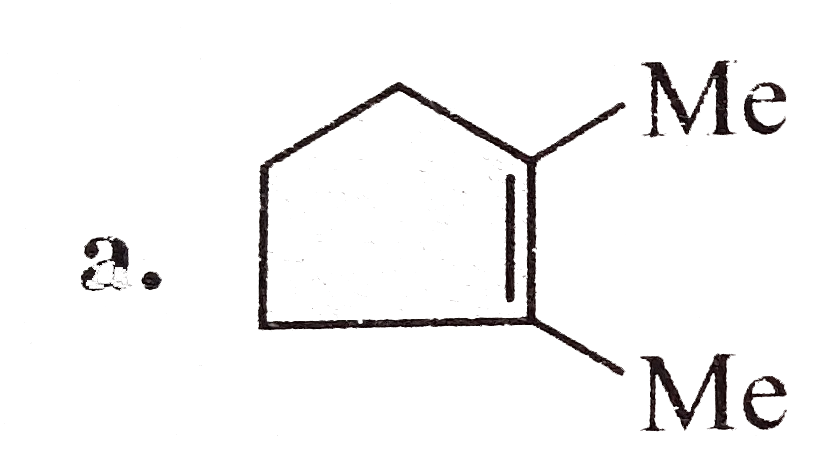Compare the results of hydroboration oxidation and mercuric ion-catalysed hydration for
Cyclohexyl-actylene
To compare the results of hydroboration-oxidation and mercuric ion-catalyzed hydration for cyclohexylacetylene, we will analyze each reaction step by step.
Step 1: Hydroboration-Oxidation of Cyclohexylacetylene
1. Hydroboration:
- Cyclohexylacetylene (a terminal alkyne) is treated with diisobutylborane (B2H8) in THF.
- The reaction involves a syn addition, where the boron atom attaches to the less substituted carbon (the one with more hydrogen) due to steric hindrance from the bulky groups.
- This results in the formation of a trialkylborane intermediate.
2. Oxidation:
- The trialkylborane is then oxidized using hydrogen peroxide (H2O2) in a basic medium (like NaOH).
- This oxidation replaces the boron atom with a hydroxyl group (-OH), leading to the formation of an enol (vinyl alcohol).
- The enol is unstable and undergoes tautomerization, shifting the double bond and forming a more stable aldehyde.
Final Product from Hydroboration-Oxidation: Aldehyde (specifically, cyclohexylacetaldehyde).
Step 2: Mercuric Ion-Catalyzed Hydration of Cyclohexylacetylene
1. Reaction Setup:
- Cyclohexylacetylene is treated with mercuric sulfate (HgSO4), water (H2O), and sulfuric acid (H2SO4).
- The mercuric ion acts as a catalyst, facilitating the hydration of the alkyne.
2. Markovnikov Addition:
- The reaction follows Markovnikov's rule, where the hydroxyl group (-OH) attaches to the more substituted carbon (the one with fewer hydrogens).
- This results in the formation of an enol, which is also unstable.
3. Tautomerization:
- Similar to the previous reaction, the enol undergoes tautomerization, shifting the double bond to form a more stable ketone.
Final Product from Mercuric Ion-Catalyzed Hydration: Ketone (specifically, cyclohexyl methyl ketone).
Comparison of Results
- Hydroboration-Oxidation yields an aldehyde (cyclohexylacetaldehyde) following the anti-Markovnikov rule.
- Mercuric Ion-Catalyzed Hydration yields a ketone (cyclohexyl methyl ketone) following Markovnikov's rule.
Summary of Key Differences:
- Product Type: Aldehyde vs. Ketone.
- Mechanism: Hydroboration-Oxidation follows anti-Markovnikov addition, while mercuric ion-catalyzed hydration follows Markovnikov addition.
- Cyclohexylacetylene (a terminal alkyne) is treated with diisobutylborane (B2H8) in THF.
- The reaction involves a syn addition, where the boron atom attaches to the less substituted carbon (the one with more hydrogen) due to steric hindrance from the bulky groups.
- This results in the formation of a trialkylborane intermediate.
- The trialkylborane is then oxidized using hydrogen peroxide (H2O2) in a basic medium (like NaOH).
- This oxidation replaces the boron atom with a hydroxyl group (-OH), leading to the formation of an enol (vinyl alcohol).
- The enol is unstable and undergoes tautomerization, shifting the double bond and forming a more stable aldehyde.
- Cyclohexylacetylene is treated with mercuric sulfate (HgSO4), water (H2O), and sulfuric acid (H2SO4).
- The mercuric ion acts as a catalyst, facilitating the hydration of the alkyne.
- The reaction follows Markovnikov's rule, where the hydroxyl group (-OH) attaches to the more substituted carbon (the one with fewer hydrogens).
- This results in the formation of an enol, which is also unstable.
- Similar to the previous reaction, the enol undergoes tautomerization, shifting the double bond to form a more stable ketone.
- Mercuric Ion-Catalyzed Hydration yields a ketone (cyclohexyl methyl ketone) following Markovnikov's rule.
- Product Type: Aldehyde vs. Ketone.
- Mechanism: Hydroboration-Oxidation follows anti-Markovnikov addition, while mercuric ion-catalyzed hydration follows Markovnikov addition.
Topper's Solved these Questions
- BOOK - MOTIONCHAPTER - HYDROCARBON EXERCISE - QUESTIONS6videos
HYDROCARBON
- BOOK - MOTIONCHAPTER - HYDROCARBON EXERCISE - Exercise - 185videos
HYDROCARBON
- BOOK - MOTIONCHAPTER - GRIGNARD REAGENTEXERCISE - EXERCISE-216videos
GRIGNARD REAGENT
- BOOK - MOTIONCHAPTER - IONIC EQUILIBRUIMEXERCISE - Exercise -4 (Level -II)14videos
IONIC EQUILIBRUIM
Similar Questions
Knowledge Check
- Question 1 - Select One or More
Hydroboration oxidation and acid hydration will yield the same product in case of:
A Bb. Me−≡−MeC
Bb. Me−≡−MeC D
D
- Question 2 - Select One
Acid catalysed hydration, hydroboration - oxidation, and oxymercuration - demercuration will give different products in
A B
B C
C D
D
- Question 3 - Select One
Acid catalysed hydration of alkene give alcohol. In thic reaction addition of water takes place according to Markownikov's rule. Since intermediate carbocation is formed in this reaction, rearrangment of carbocation takes place. In oxymercuration-demercuration reaction hydration of alkene takes place according to markownikov's rule. Oxymercuratio-demercuration-dermercuration no rearrangement is possible. in hydroboration-oxidation hydration of alkene takes place according to anti marjownikow's addition. in HBO reaction rearrangement is not possible. both in oxymercuration-demercuation and hydroboration-oxidation, intermediate carbocation are not formed.
Q. The product formed in the following reaction is:
 PruductA2-phenyl-2-propanolB2-phenyl-1-propanolC3-phenyl-1-propanolD1-phrnyl-2-propanol
PruductA2-phenyl-2-propanolB2-phenyl-1-propanolC3-phenyl-1-propanolD1-phrnyl-2-propanol
(a) What is meant by Hydroboration-oxidation reaction ? Illustrate it with an example.
(b) Predict the major product of acid catalysed dehydration of 1-methylcyclohexanol.View Solution(HBO) Hydroboration and Oxymercuration-Demercuration, and acid catalysed hydration will not give the same product in
View SolutionWhich of the following alkenes will give same product by any method out of hydration, hydroboration-oxidation and oxymercuration-demercuration?
View SolutionHydration reaction of alkene is catalyzed by dilute acid. Selection of acid is important . Conjugate base of the acid should not interfere in the reaction. There are other means by which alkenes can be converted to alcohols. Oxymercuration demercuration gives Markovnikoff's alcohols while hydroboration oxidation give Anti Markovnikoff's alcohol.
When subjected to acid catalyzed hydration which of the following alkene will give rearrangement alcohol as the predominant product?View SolutionElectrolysis is a phenomenon where a reaction is carried out by passing electricity through the molten electrolyte or the electrolytic solution in water. In electrolysis, electrolyte first decomposes into anions and cations and thereafter anions undergo oxidation at anode and cations undergo reduction at cathode. for example.
XY (molten ) ⇔Xn++Yn−
Oxidation at anode : Yn−−ne−→Y
Reduction at cathode Xn++ne−→X
In order to predict the electrolytic products accurately an array of substances is arranged in decreasing order tendency of oxidation of the substances or increasing order of standard reducton potential in electrochemical series. the standard electrode potentials of some species (elements,or ions) is given as under.
Cl2(g)+2e−→2Cl−,E∘=1.360V
Na++e−→Na,E∘=−2.71V
2H2O+e−→H2(g)+2OH−,E∘=−0.83V
2H++2e−→H2,E∘=OV
When aqueous solution of 100mL of 1M NaCl is electrolysed using Pt electrodes then answer the following question.
What will b e the pH of the resulting solution upon passage of 0.2F chargeView Solution

